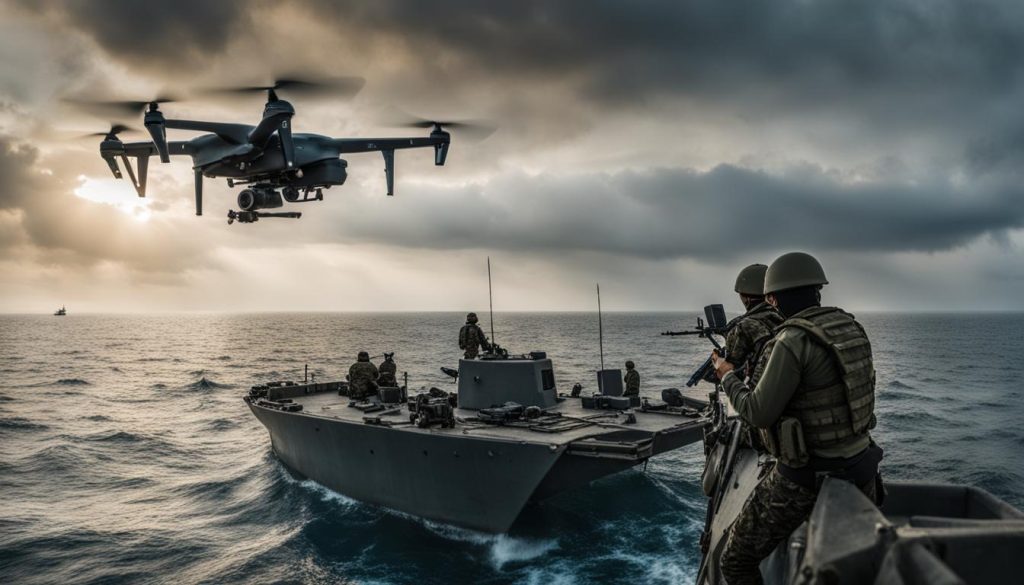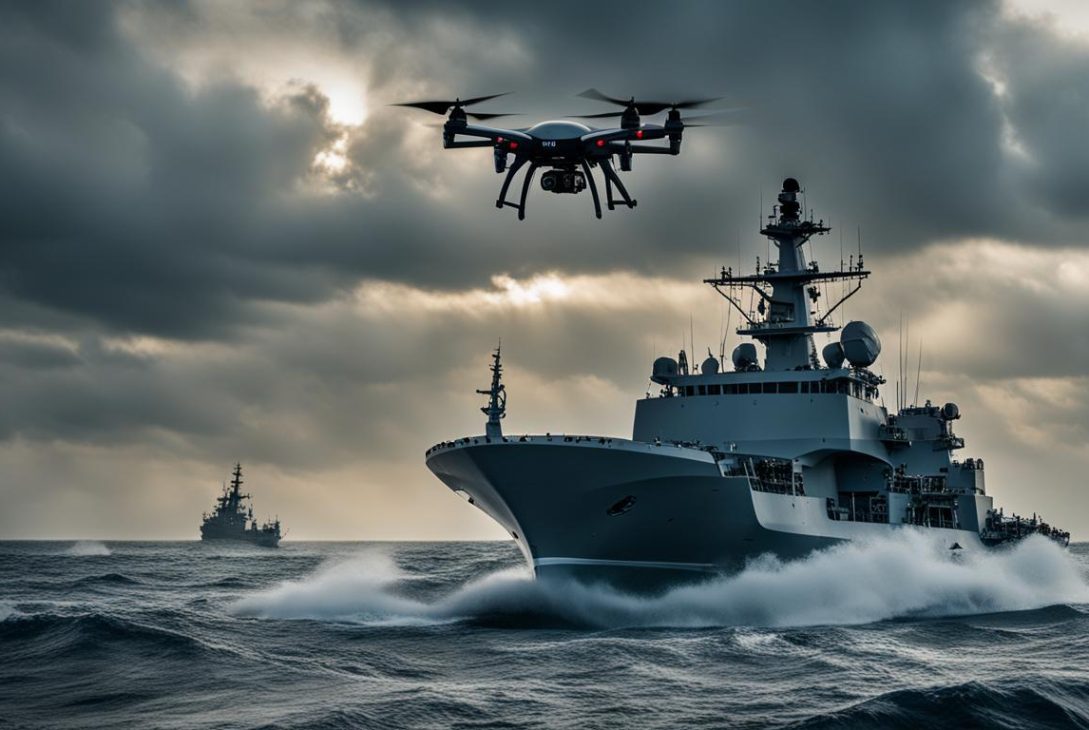The conflict in Yemen has taken a new turn with the recent deployment of sea drones by the Houthis, following a final warning from the United States and its allies. This development has significant implications for naval warfare and highlights the Houthi’s capabilities in maritime operations.
The use of sea drones by the Houthis showcases their evolving strategies in combat and their ability to adapt to changing circumstances. These unmanned underwater vehicles can be used for various purposes, including surveillance, intelligence gathering, and even targeted attacks on ships.
The deployment of sea drones by the Houthis has raised concerns among the international community, as it poses a direct threat to maritime security in the region. This development highlights the growing role of unmanned technologies in naval warfare and the challenges they pose to traditional defense systems.
As the conflict in Yemen continues to escalate, it is crucial to understand the implications of the Houthi’s sea drone deployment. This article will provide an in-depth analysis of these events, exploring the chronology of events leading up to the current escalation, the strategic implications of sea drone deployment, and the impact on naval security. Additionally, it will examine the Houthi’s naval warfare tactics, their history of maritime operations, and the international response to emerging naval threats.
Key Takeaways:
- Houthis have deployed sea drones following a final warning from the US and its allies.
- Sea drones pose a direct threat to maritime security in the region.
- The use of unmanned technologies in naval warfare is on the rise.
- The Houthi’s sea drone deployment has significant strategic implications.
- The international community is closely monitoring the situation and responding to emerging naval threats.
Houthis Deploy Sea Drone for Ship Attacks Shortly Following US and Allies’ Final Warning
In a significant escalation of maritime operations, the Houthis have deployed sea drones specifically for ship attacks. This development comes shortly after the final warning issued by the United States and its allies. The sea drone attacks pose a serious threat to naval security and have raised concerns about the increasing capabilities of the Houthis in the region.
Chronology of Events Leading to the Current Escalation
“The recent deployment of sea drones by the Houthis for ship attacks follows a series of events that have heightened tensions in the region. Here is a chronology of the key incidents that have led to the current escalation:
- The United States and its allies issue a final warning to the Houthis, urging them to cease their maritime operations.
- Shortly after the warning, the Houthis deploy sea drones specifically designed for ship attacks.
- Multiple ship attacks occur in the region, attributed to the Houthis’ sea drones.
- Naval security measures are heightened in response to the increasing threat posed by the sea drones.
The chronology of events provides crucial context to understand the sequence of actions leading up to the current escalation. The deployment of sea drones by the Houthis for ship attacks has introduced a new dimension to the ongoing conflict, necessitating a comprehensive reassessment of naval security strategies in the region.
The sea drone attacks have significantly impacted the maritime landscape, highlighting the evolving nature of modern warfare and the increasing sophistication of unmanned technologies. As the conflict continues to unfold, it remains imperative for international stakeholders to closely monitor and effectively respond to the threat posed by these sea drones.
Analysis of Houthi Naval Warfare Tactics
This section provides a comprehensive analysis of Houthi naval warfare tactics, shedding light on their historical maritime operations and the strategic implications of their recent deployment of sea drones. By examining their approach to naval warfare, we gain valuable insights into the Houthi’s military strategies and objectives in the maritime domain.
History of Houthi Maritime Operations
To understand the present-day tactics employed by the Houthis, it is crucial to delve into their history of maritime operations. The Houthis have long demonstrated their capabilities in naval warfare, particularly in the Red Sea and the Gulf of Aden. Their operations have included but are not limited to:
- Intercepting and disrupting international shipping lanes
- Targeting commercial vessels and military ships
- Conducting missile and rocket attacks from the coastline
This history of maritime aggression underscores the Houthi’s determination to challenge regional powers and disrupt maritime activities in the surrounding waters.
Strategic Implications of Sea Drone Deployment
The recent deployment of sea drones by the Houthis marks a significant shift in their naval warfare tactics. These unmanned underwater vehicles (UUVs) present unique challenges in terms of detection, interception, and countermeasures. The strategic implications of sea drone deployment are threefold:
- Enhanced operational capabilities: Sea drones enable the Houthis to extend their reach and conduct surveillance, reconnaissance, and offensive operations with unprecedented precision and stealth.
- Navigational threats: The deployment of sea drones poses a direct threat to maritime security by potentially obstructing shipping routes, placing commercial vessels, and military assets at risk.
- Escalation potential: Sea drones add a new dimension to the conflict, raising concerns about the potential escalation of hostilities and the involvement of international forces in the region.
The strategic implications of sea drone deployment demand careful consideration from regional and international stakeholders who seek to maintain maritime stability and security in this crucial area.
| Strategic Implications of Sea Drone Deployment | |
|---|---|
| Enhanced operational capabilities | Sea drones offer extended reach, precision, and stealth for surveillance, reconnaissance, and offensive operations. |
| Navigational threats | Sea drones pose a risk to maritime security by potentially obstructing shipping routes and endangering commercial and military vessels. |
| Escalation potential | The introduction of sea drones adds complexity to the conflict and raises concerns about potential escalation and international involvement. |
The Impact of US and Allies’ Ultimate Ultimatum on Houthi Strategy
In the face of mounting international pressure, the Houthi rebels have been forced to reconsider their strategic approach. The ultimatum issued by the United States and its allies has had a profound impact on Houthi strategy, prompting a series of significant shifts in their military posture.
Reactions to International Pressure
The Houthi rebels have been closely monitoring the international response to their actions. The ultimatum from the US and its allies has left them with limited options. They are now faced with the difficult task of recalibrating their approach in order to mitigate the consequences of continued aggression.
The international pressure has also made it increasingly challenging for the Houthis to obtain vital resources and external support. The blockade imposed by the coalition forces has restricted their access to weapons, funds, and other essential supplies, weakening their military capabilities.
Shifts in Houthi Military Posture
The ultimatum and subsequent international pressure have prompted the Houthis to reevaluate their military posture. They have been forced to adopt a more defensive stance, focusing on consolidating their positions and fortifying key strongholds.
Furthermore, the Houthi rebels have demonstrated a shift towards asymmetric warfare tactics in response to the overwhelming military power of the US-led coalition. This includes the increased reliance on sea drones for ship attacks, which allows them to target enemy vessels while minimizing their own exposure to counterattacks.
Their use of sea drones reflects a strategic adaptation to the changing dynamics of the conflict. By deploying these advanced maritime technologies, the Houthis aim to disrupt naval operations in the region and assert their presence in the maritime domain.
The growing capabilities of the Houthi sea drones have raised concerns among military analysts, as it poses a significant challenge to naval security in the region. The Houthis’ ability to accurately target ships and conduct covert maritime operations adds a new dimension to the ongoing conflict.

Houthis Naval Strength: A Redefined Threat at Sea
When it comes to naval strength, the Houthis have emerged as a formidable force, posing a redefined threat at sea. Their capabilities and tactics have raised concerns about naval security and the stability of the region.
With the deployment of sea drones, the Houthis have showcased their evolving naval power. These unmanned vessels have the potential to disrupt maritime operations and target ships, further adding to the complexity of the conflict.
The Houthis’ naval strength is characterized by their ability to navigate the challenging waters of the Red Sea and the strategic Bab el-Mandeb strait. This gives them an advantage in terms of access and control over key maritime routes.
“The deployment of sea drones by the Houthis marks a significant shift in their naval capabilities, presenting a new challenge for naval security in the region.” – Naval Warfare Analyst
Their naval strength not only poses a threat to commercial shipping but also has implications for international military operations and humanitarian efforts in the area. It raises concerns about the safety of critical infrastructure, including ports and oil installations.
Naval security in the region must adapt to the evolving threats presented by the Houthis. A comprehensive understanding of their capabilities and strategies is crucial to effectively counter their naval power.
Overall, the naval capabilities of the Houthis have redefined the threat at sea. Their advancing technology and strategic positioning have made them a force to be reckoned with, necessitating enhanced measures to ensure maritime security in the region.
Escalation Dynamics: Understanding the Rise in Sea Drone Attacks
In recent years, there has been a significant increase in sea drone attacks carried out by the Houthis, marking an escalation in naval warfare tactics. To fully comprehend the implications of these attacks, it is crucial to explore the technological evolution of drones in warfare and compare them with previous naval engagements.
The Technological Evolution of Drones in Warfare
The rise in sea drone attacks can be attributed to the rapid advancement of drone technology. Drones have evolved from simple surveillance tools to sophisticated weapons capable of carrying out precise strikes with devastating effects. These technological advancements have made drones an attractive option for naval operations, providing increased range, maneuverability, and stealth. The development of autonomous capabilities also enables drones to operate independently, reducing the risk to human operators.
Comparison with Previous Naval Engagements
When comparing sea drone attacks with previous naval engagements, several key differences emerge. Traditionally, naval warfare involved conventional warships and aircraft carriers, which required extensive resources and manpower. Sea drones, on the other hand, offer a cost-effective alternative with lower resource requirements. Their small size and ability to blend in with civilian vessels make it difficult for conventional navies to detect and counter them effectively.
The unpredictability and agility of sea drones present unique challenges to naval forces. Unlike traditional naval engagements, sea drones can be easily launched from various platforms, such as fishing boats or small vessels, granting the Houthis the element of surprise and allowing them to operate in unconventional ways. This shift in tactics requires naval forces to adapt and develop new strategies to counter the evolving threat landscape.
| Comparison | Previous Naval Engagements | Sea Drone Attacks |
|---|---|---|
| Resource Requirements | High (warships, aircraft carriers) | Low (small vessels) |
| Detection | Relatively easy | Difficult (small size, civilian vessel camouflage) |
| Tactics | Conventional | Unconventional (element of surprise) |
This table provides a comparison between previous naval engagements and sea drone attacks, highlighting the contrasting aspects of these two forms of warfare. It emphasizes the shift in resource requirements, detection challenges, and the unconventional tactics employed by the Houthis.
Understanding the escalation dynamics behind the rise in sea drone attacks is essential for naval forces to effectively address this evolving threat. By comprehending the technological evolution of drones and comparing them to previous naval engagements, militaries can develop strategies to counter the increasing use of sea drones in conflicts.
Unpacking the Yemen Conflict: Regional Instability and Its Global Impact
The Yemen conflict has had far-reaching consequences both regionally and globally, leading to significant regional instability. The implications of this conflict extend beyond the borders of Yemen and have the potential to impact global security, particularly in the context of naval warfare.
The Yemen conflict, which began in 2014, is a complex and multifaceted struggle involving various internal and external actors. It has resulted in widespread violence, humanitarian crises, and political upheaval in the region. The conflict’s roots lie in longstanding political, social, and economic grievances within Yemen, compounded by external interventions and geopolitical competition.
The regional instability resulting from the Yemen conflict has disrupted maritime operations and posed significant challenges to naval security. The ongoing hostilities have seen an increase in naval clashes, blockades, and the deployment of unconventional tactics, such as sea drones, by the warring parties. This has added another layer of complexity to the conflict and raised concerns about the safety of international shipping routes in the region.

“The Yemen conflict has become a source of regional instability, with ripple effects reaching far beyond the borders of the country. Its impact on naval warfare and maritime operations cannot be underestimated.”
Furthermore, the Yemen conflict has broader global implications. The geopolitical dynamics and power struggles in the region, influenced by the involvement of various external actors, have the potential to disrupt global security and stability. The conflict has created an environment conducive to the spread of extremist ideologies, increased arms proliferation, and the escalation of proxy conflicts.
The global impact of the Yemen conflict necessitates international attention and efforts to mitigate its consequences. Diplomatic and humanitarian initiatives are crucial to addressing the underlying causes of the conflict and finding a sustainable solution. Additionally, cooperation among regional and international actors is essential to ensure the security of maritime trade routes and prevent further escalation.
| Regional Instability | Global Impact |
|---|---|
|
|
In conclusion, the Yemen conflict has significantly contributed to regional instability and has wide-ranging global implications. The conflict’s impact on naval warfare, maritime operations, and the security of international shipping routes necessitates concerted international efforts to address its root causes and promote stability in the region.
Houthi Sea Drone Capabilities: A New Challenge to Naval Security
The deployment of sea drones by the Houthis has introduced a new and significant challenge to naval security. These unmanned maritime vehicles possess advanced technologies that enable them to carry out targeted attacks and disrupt maritime operations. An assessment of Houthi sea drone capabilities sheds light on the evolving nature of naval warfare and the urgent need for effective countermeasures.
Assessment of Houthi Sea Drone Technologies
Houthi sea drones are equipped with sophisticated technologies that enhance their operational capabilities. These include:
- Advanced Surveillance Systems: Houthi sea drones are equipped with high-resolution cameras and advanced sensor systems, enabling them to conduct surveillance and gather real-time intelligence on potential targets.
- Precision Navigation: These drones utilize precise navigation systems, such as GPS and inertial guidance, to accurately navigate through maritime areas, making them highly effective in carrying out targeted attacks.
- Anti-Ship Weapons: Houthi sea drones can be armed with anti-ship missiles or explosive devices, posing a direct threat to naval vessels and other maritime assets.
The advanced capabilities of Houthi sea drone technologies significantly raise the stakes in naval warfare. Their ability to conduct surveillance, navigate with precision, and deliver destructive payloads make them a formidable force that demands immediate attention and robust countermeasures.
International Response to Emerging Naval Threats
The emergence of Houthi sea drone capabilities has prompted a response from the international community to address these emerging naval threats. Efforts are underway to develop and implement strategies aimed at mitigating the risks posed by these unmanned maritime vehicles.
International response to Houthi sea drone capabilities includes:
- Defense Cooperation: Countries with advanced naval capabilities are collaborating to enhance their collective defense capabilities against sea drones. This includes intelligence sharing, joint training exercises, and the development of integrated defense systems.
- Technological Advancements: Governments and defense industries are investing in research and development to develop advanced technologies that can detect, track, and neutralize sea drones. This includes the deployment of radar systems, jamming devices, and underwater defense mechanisms.
- Legislative Measures: International organizations and governments are formulating regulations and policies to address the challenges posed by sea drones. This includes establishing legal frameworks for the operation and use of unmanned maritime vehicles and implementing strict control measures.
The international response to Houthi sea drone capabilities reflects the recognition of the need to safeguard naval security and protect vital maritime interests. Collaborative efforts and innovative countermeasures are essential to effectively respond to the evolving nature of naval threats.
The Strategic Role of Sea Drones in Houthis Ship Targeting
The use of sea drones by the Houthi forces plays a critical strategic role in their ship targeting operations. These unmanned underwater vehicles (UUVs) equipped with advanced technology enable the Houthis to execute precise attacks on naval vessels, further enhancing their military capabilities in the conflict.
Sea drones provide the Houthis with several advantages in their ship targeting endeavors. By deploying these autonomous devices, the Houthis can effectively extend their operational reach beyond traditional naval warfare tactics. Sea drones offer enhanced mobility, stealth, and versatility, allowing the Houthis to access and disrupt maritime areas that were previously difficult to navigate.
These UUVs are equipped with various sensors, cameras, and navigation systems that enable them to gather crucial intelligence and accurately identify potential targets. By analyzing the gathered data, the Houthis can strategically plan and execute their ship targeting operations with precision. This strategic use of sea drones allows them to strike key naval assets, disrupting their adversaries’ logistics, supply chains, and overall naval supremacy.
Furthermore, sea drones contribute to the Houthi’s broader military strategy in the conflict. Their deployment provides the Houthis with a cost-effective means of conducting naval operations against more technologically advanced and heavily armed naval forces. This strategic approach allows the Houthis to level the playing field, maximizing their impact and exploiting the vulnerabilities of their opponents.
As sea drones become an increasingly integral component of the Houthi arsenal, their strategic value in ship targeting operations cannot be understated. These devices empower the Houthis to challenge the dominance of their adversaries at sea, disrupt regional stability, and assert their influence in the ongoing conflict.
| Advantages of Sea Drones in Houthi Ship Targeting | Impact on Houthi Military Strategy |
|---|---|
|
|
Examining Allies’ Final Ship Attacks and the Response from the Houthis
In this section, we will delve into the allies’ final ship attacks and how the Houthis responded to them. To provide a comprehensive understanding of the events, we will present a chronology of events leading to the current escalation and analyze the military and political calculus behind the Houthi responses.
Chronology of Events Leading to the Current Escalation
Before we explore the Houthi responses, it is crucial to have a clear timeline of the events that led to the current escalation. This chronology will provide valuable insights into the sequence of actions and decisions taken by both sides and how they influenced the subsequent dynamics of the conflict.
We begin with the allies’ final ship attacks, examining the precise nature of these attacks, including targets and their strategic implications. By understanding the context in which these attacks occurred, we can better appreciate the significance of the Houthi responses.
The Military and Political Calculus of Houthi Responses
Next, we shift our focus to the Houthi responses, delving into the military and political factors that shaped their choices and decisions. By analyzing their responses through this lens, we can gain insights into their strategic thinking, adaptive capabilities, and overall objectives.
Furthermore, we will explore the dynamic relationship between the military and political calculus of the Houthi responses. This analysis will shed light on how their military actions are intertwined with their broader political objectives and how these factors influence their decision-making process.
Overall, this section aims to provide a nuanced understanding of the allies’ final ship attacks and the subsequent Houthi responses. By examining the chronology of events and the military and political calculus behind these responses, we can gain essential insights into the dynamics of the conflict and the strategic decision-making of the Houthis.
Conclusion
In conclusion, the deployment of sea drones by the Houthis after receiving a final warning from the US and its allies has significantly impacted naval warfare and regional stability. The sea drone attacks carried out by the Houthis have demonstrated their evolving capabilities and strategic adaptation in maritime operations. These attacks have posed a new challenge to naval security and highlighted the need for enhanced defense measures.
The use of sea drones by the Houthis has shown the technological evolution of drones in warfare and their potential for disruptive actions at sea. This development has also raised concerns about the overall impact on global security and the potential for further escalation of the conflict.
It is crucial for international responses to address the challenges posed by sea drone attacks and the implications they have for regional stability. Cooperation between nations, the sharing of intelligence, and the development of advanced defense systems are essential in countering these emerging threats and ensuring the security of maritime operations.
FAQ
What is the significance of Houthis deploying sea drones after the US and its allies issued a final warning?
The deployment of sea drones by the Houthis following the final warning from the US and its allies indicates a significant escalation in naval warfare tactics and highlights the Houthi’s growing capabilities in maritime operations.
What is the timeline of events leading up to the sea drone attacks by the Houthis?
The timeline of events leading to the sea drone attacks by the Houthis includes the final warning issued by the US and its allies, followed shortly by the deployment of sea drones for ship attacks.
Can you provide an analysis of Houthi naval warfare tactics?
Houthi naval warfare tactics involve a combination of historical maritime operations and the recent deployment of sea drones, which have strategic implications for regional and international security.
How has the ultimatum from the US and its allies influenced Houthi strategy?
The ultimatum issued by the US and its allies has had a significant impact on Houthi strategy, leading to reactions to international pressure and shifts in their military posture.
What is the naval strength of the Houthis and how does it pose a threat at sea?
The naval strength of the Houthis poses a redefined threat at sea due to their capabilities and challenges they present to naval security.
What are the dynamics behind the rise in sea drone attacks by the Houthis?
The rise in sea drone attacks by the Houthis is a result of the technological evolution of drones in warfare, which has contributed to their use in maritime operations and engagement in naval conflicts.
How does the Yemen conflict impact regional instability and global security?
The Yemen conflict has wide-ranging implications for regional instability and global security, with naval warfare playing a significant role in the complexities of the conflict.
What are the capabilities of Houthi sea drones and how do they challenge naval security?
Houthi sea drones possess advanced technologies that challenge naval security, and their potential impact has prompted international responses to address these emerging naval threats.
What is the strategic role of sea drones in Houthi ship targeting operations?
Sea drones play a strategic role in Houthi ship targeting operations, contributing to their overall military strategy in the ongoing conflict.
What has been the response of the Houthis to the final ship attacks carried out by the allies?
The response of the Houthis to the final ship attacks carried out by the allies demonstrates the dynamics of the conflict and the strategic decision-making of the Houthis in light of these attacks.
Source Links
houthis deploy sea drone after us Houthis Naval Strength: A Redefined Threat at Sea Strategic Implications of Sea Drone Deployment The Impact of US and Allies' Ultimate Ultimatum on Houthi Strategy
Last modified: January 17, 2024





